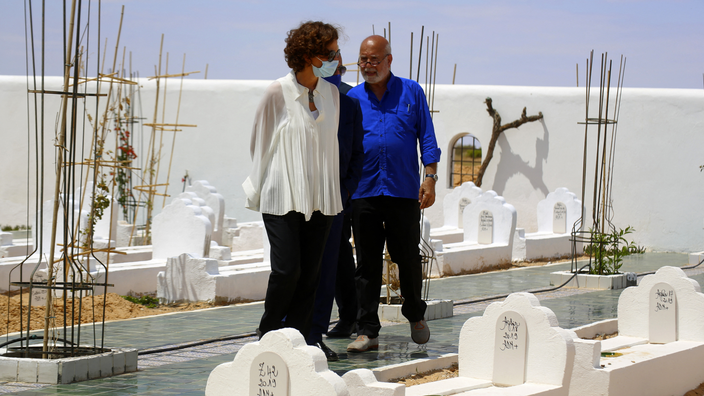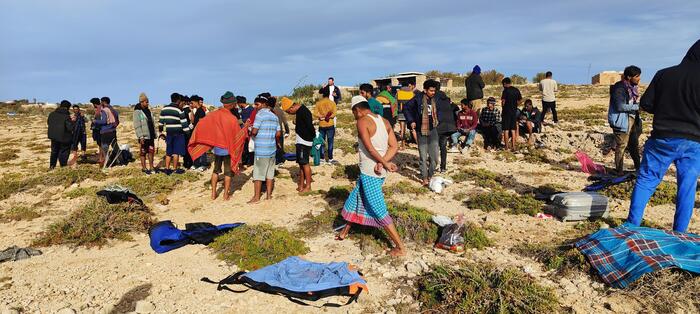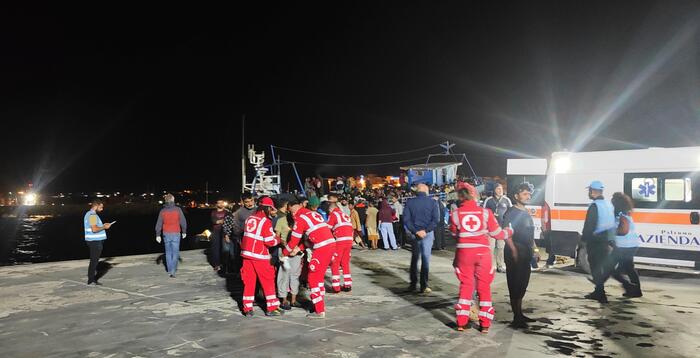Barely inaugurated and already half full.
In the south of Tunisia, a palatial and flowery cemetery welcomes the remains of unknown migrants who died on the way to Europe, to restore their dignity and perhaps, one day, their name.
Traditional 17th century door, aisles of hand-painted ceramics and, under a harmonious white dome, a prayer room for all religions: the
“African Garden”
is the work of Rachid Koraïchi, Algerian artist and man of faith .
The migrants buried there,
"damned by the sea"
,
"faced the Sahara, gangsters, terrorists"
, sometimes torture or shipwreck, he underlines.
"I wanted to give them a start in paradise"
, after the hell of the crossing.
At the end of 2018, he bought in Zarzis, near the Libyan border, this land surrounded by olive trees, inaugurated on Wednesday by the director of Unesco Audrey Azoulay.
Read also: Audrey Azoulay: "Unesco shows the concrete added value of multilateralism"
"Black dress woman, Hachani beach", "Black knit man, 4 Seasons Hotel beach"
: more than 200 numbered white tombs are already lined up, surrounded by five olive trees symbolizing the pillars of Islam and twelve vines for the Christian apostles. Jasmines, gallant nights and other shrubs perfume this place where bodies sometimes arrive in a state of putrefaction. Leaving from Libya or sometimes from Tunisia, they are fished off, or beached in southern Tunisia due to sea currents.
Vicky, a 26-year-old Nigerian who arrived in Tunisia on foot after several unsuccessful attempts to reach Italy from Libya, has her throat tight as she sweeps the aisles.
“Going to Europe was my dream to do fashion, but I lived through hell
,” she says.
When I see that, I'm not sure I want to go back to sea.
"
Read also: The "triangle", this new route for migrants to Europe
Buildings are planned to carry out autopsies on site, in order to facilitate the identification work. Analyzes are currently being carried out by the Gabès hospital, 140 kilometers away, forcing the authorities to transport the remains in precarious conditions. A Libyan family came to pray at the grave of a young man, identified thanks to fellow travelers.
“They were offered to bring the body home, but the father replied 'God has abandoned Libya, keep it here'”
, remembers Rachid Koraïchi.
The 74-year-old artist, exhibited in London, New York or Paris, himself lost a brother, swept away by the current while swimming in the Mediterranean.
He designed this garden
"to help families mourn, knowing that there is a dignified burial place
.
"
"It is also a symbolic place, like the tomb of the unknown soldier, because everyone is responsible for this tragedy"
, he underlines.
Read also: Italy, Tunisians' route to France
A member of the Tijaniyya, an influential Sufi brotherhood, he launched this project, which he fully finances, after hearing of the difficulties in Zarzis, a large fishing town, in burying the dozens of bodies arriving each summer.
Since the beginning of the 2000s, the municipality, one of the few to take care of the remains of migrants in the region, has buried more than 1,000, from Africa, Asia or neighboring towns.
"Many of the youth of Zarzis left for Europe by sea, there were deaths, and when we see these emigrants, we see our children,"
the mayor, Mekki Lourraiedh told AFP.
Over 600 strangers
In the old cemetery, a sandy ground near a former landfill, the municipal roadmakers helped by volunteers buried more than 600 strangers. Only the burial of a Nigerian woman, Rose-Marie, is marked by a little concrete and a few flowers.
"If we had the means we would not leave the cemetery in this state,"
admits the mayor.
This municipal land was almost full when a hundred bodies arrived in July 2019. The first graves had to be dug in the Jardin d'Afrique even before the work began. Since then, the dead have continued to pour in every week, especially in summer, a season of departures marked this year by a marked increase in crossings from Tunisia or neighboring Libya, which is struggling to emerge from a decade of conflict. More than 200 white bricks mark the empty spaces, but Rachid Koraïchi fears that they will all be occupied by the end of the summer.
"We have already planned a gate and asked to buy the adjoining land, to enlarge the cemetery."









